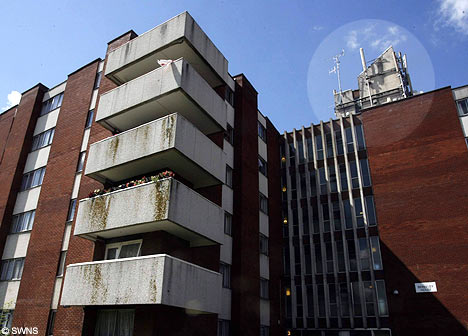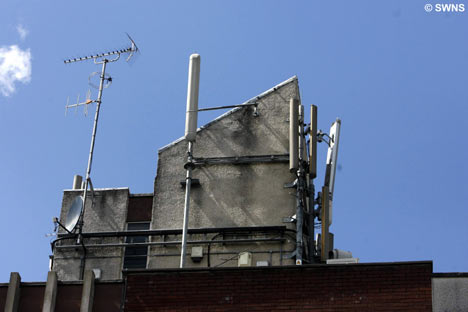
Anger: The mast (circled) on the block known to locals as the Tower of Doom
Three have died and another four have battled the disease since two masts were erected on the roof of the five-storey block which has become known locally as the Tower of Doom.
The cancer rate on the top floor - where residents of five of the eight flats have been affected and the three who died all lived - is 20 per cent, ten times the national average.
Residents of Berkeley House in Staple Hill, Bristol, also complain of terrible headaches and other ailments which they blame on radiation from the masts.
Orange has agreed to remove its mast after a five-year campaign by residents and pressure from the local authority. But it has caused anger with plans to move it to a residential street nearby.
The other mast belongs to Vodafone, which has no plans to move it.
The most recent death was that of John Llewellin, 63, who lost his battle against bowel cancer two weeks ago.
Scroll down for more

Anger: The mast (circled) on the block known to locals as the Tower of Doom
Two years ago, Barbara Wood died in her 70s from breast cancer. Two years earlier Joyce Davies died, also from breast cancer.
The other victims on the top floor are Hazel Frape, 63, who has had breast cancer, and 89-year-old Phyllis Smith who moved out after she contracted the same disease.
On the fourth floor Bernice Mitchell, 69, has battled womb cancer. On the second floor, 78-year-old Barbara Watts, who has lived in the block for 31 years, is in remission from breast cancer.
Many of the 110 residents, including Doreen Sheppard, 74, have complained of headaches and other health problems.
She said: "The masts are bound to be doing something. I get terrible headaches and I've started suffering from Meniere's disease, where I lose my balance. I'm worried about the children on the estate as there are so many of them now."
Both masts were erected in 1994. South Gloucestershire Council served a notice asking for them to be removed when the ten-year contract expired three years ago.
But because current guidelines say there is no risk from radiation the council does not have a legal right to force their removal.
After a long legal battle Orange has submitted a planning application to put the mast on top of a shopping precinct in a street near homes, a primary school and a public library.
Jeanette McCormack, 69, who has led a campaign against the mast, said a petition against the new location had gathered more than 200 names.
She added: "People of all ages who live and work near the mast will be exposed to the radiation and so there's a lot of anger about it."
World Health Organisation guidelines have dismissed the risks of masts despite other evidence which has found they are harmful.
A spokesman for Orange said the company takes health and safety very seriously.
He added that the company was satisfied its mobile phone base stations do not present a health risk.
Vodafone is working on a new longterm lease from South Gloucestershire Council. A spokesman said the company took residents' concerns "extremely seriously" and would continue to work with them and the council to provide reassurance.

Up, up and away: Orange's controversial mobile phone mast will be no longer be a blot on the landscape